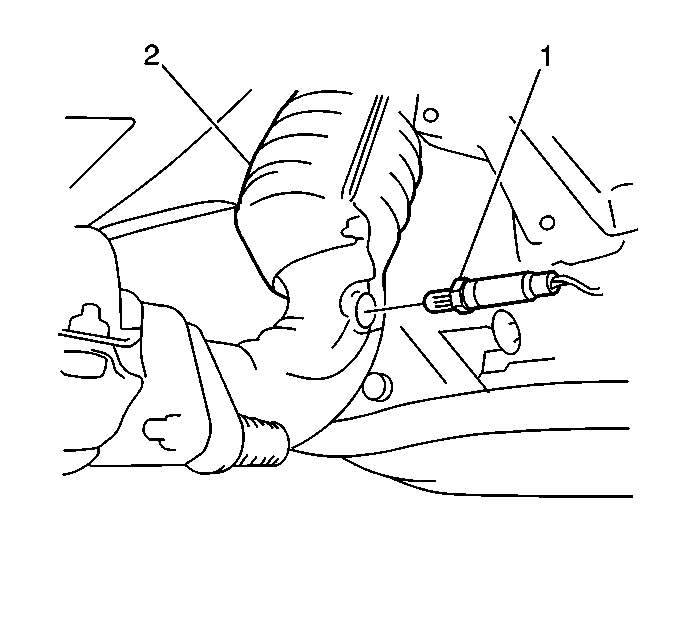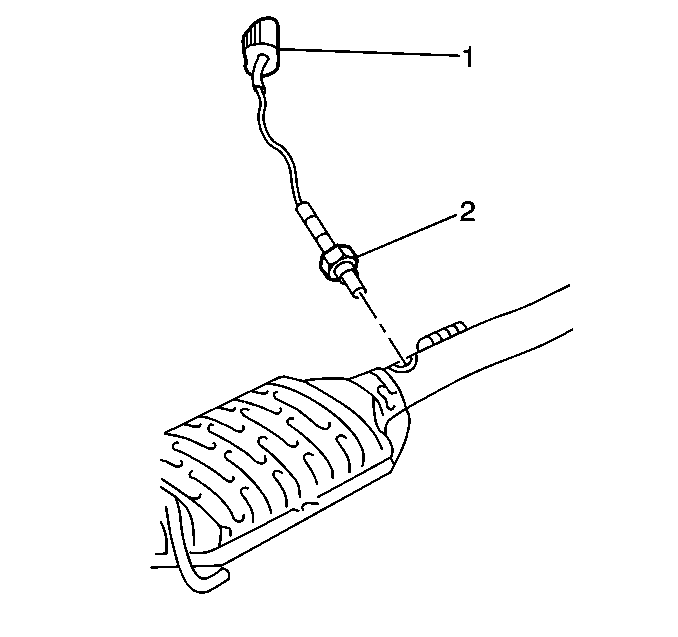Heated Oxygen Sensor Replacement - Sensor 2 With PUP-TWC
HO2S 2 w/PUP-TWC
Notice: Do not remove the pigtail from either the heated oxygen sensor (HO2S) or the oxygen sensor (O2S). Removing the pigtail or the connector will affect sensor operation.
Handle the oxygen sensor carefully. Do not drop the HO2S. Keep the in-line electrical connector and the louvered end free of grease, dirt, or other contaminants. Do not use cleaning solvents of any type. Do not repair the wiring, connector or terminals. Replace the oxygen sensor if the pigtail wiring, connector, or terminal is damaged. This external clean air reference is obtained by way of the oxygen sensor signal and heater wires. Any attempt to repair the wires, connectors, or terminals could result in the obstruction of the air reference and degraded sensor performance. The following guidelines should be used when servicing the heated oxygen sensor:| • | Do not apply contact cleaner or other materials to the sensor or vehicle harness connectors. These materials may get into the sensor causing poor performance. |
| • | Do not damage the sensor pigtail and harness wires in such a way that the wires inside are exposed. This could provide a path for foreign materials to enter the sensor and cause performance problems. |
| • | Ensure the sensor or vehicle lead wires are not bent sharply or kinked. Sharp bends or kinks could block the reference air path through the lead wire. |
| • | Do not remove or defeat the oxygen sensor ground wire, where applicable. Vehicles that utilize the ground wired sensor may rely on this ground as the only ground contact to the sensor. Removal of the ground wire will cause poor engine performance. |
| • | Ensure that the peripheral seal remains intact on the vehicle harness connector in order to prevent damage due to water intrusion. The engine harness may be repaired using Packard's Crimp and Splice Seals Terminal Repair Kit. Under no circumstances should repairs be soldered since this could result in the air reference being obstructed. |
Removal Procedure
Important: The HO2S may be difficult to remove at temperatures above 48°C (120°F). In order to prevent damage to any threads in the exhaust manifold, allow the exhaust system to cool down before attempting to remove the HO2S.
- Disconnect the HO2S 2 electrical connector.
- Raise and suitably support the vehicle. Refer to Lifting and Jacking the Vehicle in General Information.
- Remove the HO2S 2 (1) from the exhaust pipe below the PUP-TWC (2).
Caution: To avoid any vehicle damage, serious personal injury or death when major components are removed from the vehicle and the vehicle is supported by a hoist, support the vehicle with jack stands at the opposite end from which the components are being removed and strap the vehicle to the hoist.

Installation Procedure
- Install HO2S 2 (1) into the exhaust pipe below the PUP-TWC (2).
- Lower the vehicle.
- Connect the HO2S 2 electrical connector.

Notice: Replacement components must be the correct part number for the application. Components requiring the use of the thread locking compound, lubricants, corrosion inhibitors, or sealants are identified in the service procedure. Some replacement components may come with these coatings already applied. Do not use these coatings on components unless specified. These coatings can affect the final torque, which may affect the operation of the component. Use the correct torque specification when installing components in order to avoid damage.
Important: The new HO2S 1 comes with an anti-seize coating on the sensor threads. Take precautions in order to prevent the removal of any of the anti-seize coating prior to installation. If the sensor was removed and is being reinstalled, an anti-seize compound must be applied to the threads before installation.
Tighten
Tighten HO2S sensor to 45 N·m (32 lb ft).
Heated Oxygen Sensor Replacement - Sensor 2 Without PUP-TWC
HO2S 2 w/oPUP-TWC
Notice: Do not remove the pigtail from either the heated oxygen sensor (HO2S) or the oxygen sensor (O2S). Removing the pigtail or the connector will affect sensor operation.
Handle the oxygen sensor carefully. Do not drop the HO2S. Keep the in-line electrical connector and the louvered end free of grease, dirt, or other contaminants. Do not use cleaning solvents of any type. Do not repair the wiring, connector or terminals. Replace the oxygen sensor if the pigtail wiring, connector, or terminal is damaged. This external clean air reference is obtained by way of the oxygen sensor signal and heater wires. Any attempt to repair the wires, connectors, or terminals could result in the obstruction of the air reference and degraded sensor performance. The following guidelines should be used when servicing the heated oxygen sensor:| • | Do not apply contact cleaner or other materials to the sensor or vehicle harness connectors. These materials may get into the sensor causing poor performance. |
| • | Do not damage the sensor pigtail and harness wires in such a way that the wires inside are exposed. This could provide a path for foreign materials to enter the sensor and cause performance problems. |
| • | Ensure the sensor or vehicle lead wires are not bent sharply or kinked. Sharp bends or kinks could block the reference air path through the lead wire. |
| • | Do not remove or defeat the oxygen sensor ground wire, where applicable. Vehicles that utilize the ground wired sensor may rely on this ground as the only ground contact to the sensor. Removal of the ground wire will cause poor engine performance. |
| • | Ensure that the peripheral seal remains intact on the vehicle harness connector in order to prevent damage due to water intrusion. The engine harness may be repaired using Packard's Crimp and Splice Seals Terminal Repair Kit. Under no circumstances should repairs be soldered since this could result in the air reference being obstructed. |
Removal Procedure
Important: The HO2S may be difficult to remove at temperatures above 48°C (120°F). In order to prevent damage to any threads in the exhaust manifold, allow the exhaust system to cool down before attempting to remove the HO2S.
- Raise and suitably support the vehicle. Refer to Lifting and Jacking the Vehicle in General Information.
- Pull the HO2S 2 electrical connector (1) through the floor pan.
- Disconnect the HO2S 2 (2) electrical connector.
- Remove the HO2S 2 (2) from the exhaust pipe.
Caution: To avoid any vehicle damage, serious personal injury or death when major components are removed from the vehicle and the vehicle is supported by a hoist, support the vehicle with jack stands at the opposite end from which the components are being removed and strap the vehicle to the hoist.

Installation Procedure
- Install HO2S 2 (2) into the exhaust pipe.
- Connect the HO2S 2 electrical connector.
- Insert the HO2S 2 electrical connector (1) up through the opening in the floor pan.
- Lower the vehicle.

Notice: Replacement components must be the correct part number for the application. Components requiring the use of the thread locking compound, lubricants, corrosion inhibitors, or sealants are identified in the service procedure. Some replacement components may come with these coatings already applied. Do not use these coatings on components unless specified. These coatings can affect the final torque, which may affect the operation of the component. Use the correct torque specification when installing components in order to avoid damage.
Important: The new HO2S 2 comes with an anti-seize coating on the sensor threads. Take precautions in order to prevent the removal of any of the anti-seize coating prior to installation. If the sensor was removed and is being reinstalled, an anti-seize compound must be applied to the threads before installation.
Tighten
Tighten HO2S sensor to 45 N·m (32 lb ft).
